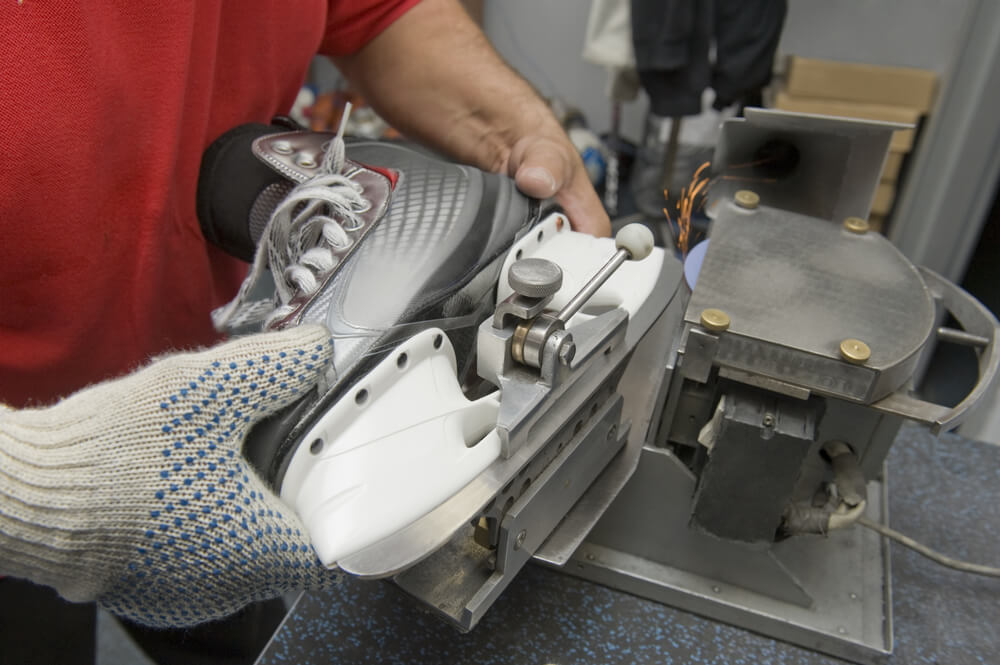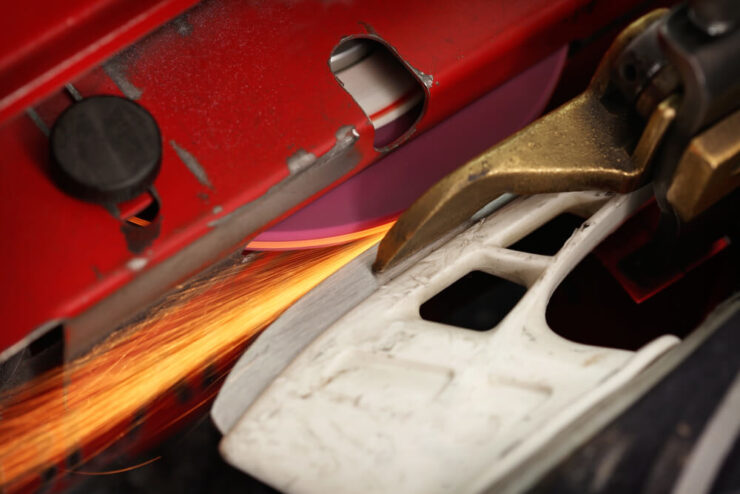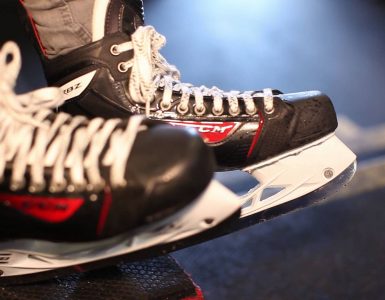Ice hockey is a fast-paced, physical sport that demands speed, control, and agility on the ice. While having the right equipment is essential for optimal performance, many ice hockey players overlook one of the most critical components of their gear: their skates.
Proper skate maintenance, including regular sharpening, is essential for maximizing your skating performance and prolonging the life of your skates. In this article, we will explore the importance of skate sharpening, the science behind the process, and the factors that affect the frequency of sharpening.
We will also provide tips for maintaining your skates, finding a skilled sharpening professional, and deciding between sharpening and replacing your skates. By following these tips and taking good care of your skates, you can help ensure that they are always performing at their best, allowing you to stay ahead of the competition on the ice.
Contents
- 1 Skate Sharpening: Why it Matters
- 2 The Science Behind Skate Sharpening: Understanding the Process
- 3 Signs Your Skates Need Sharpening: How to Tell When It’s Time
- 4 Frequency of Skate Sharpening: How Often is Too Often?
- 5 Factors Affecting Sharpening Frequency: Ice Conditions, Playing Style, and More
- 6 How to Extend Time Between Sharpenings: Tips for Maintaining Your Skates
- 7 Finding a Sharpening Professional: Where to Go and What to Look For?
- 8 DIY Skate Sharpening: Pros and Cons of Sharpening at Home
- 9 Sharpening vs. Replacing: How to Decide Which Option is Right for You?
- 10 Conclusion: Putting It All Together and Maximizing Your Skating Performance
Skate Sharpening: Why it Matters
Skate sharpening is a critical aspect of ice hockey equipment maintenance that can greatly impact your performance on the ice. The edges of your skates are what allow you to grip the ice and make sharp turns, sudden stops, and quick accelerations. If your blades are dull or unevenly sharpened, you may find yourself slipping, losing speed, or unable to control your movements on the ice.
Skate sharpening involves removing a small amount of metal from the blade to create a sharp, uniform edge. It’s important to note that the angle and depth of the cut can greatly impact the performance of your skates. A skilled skate sharpener will take into account your body weight, skating style, and the specific ice conditions you’ll be playing on when deciding on the angle and depth of the cut.
When skates are first purchased, they typically come with a factory-sharpened edge, but this may not be optimal for your specific needs. Many players prefer to have their skates sharpened to their individual preferences, which can improve their performance and comfort on the ice.
Skate sharpening is not just about performance, it is also about safety. Dull or unevenly sharpened blades can increase your risk of injury on the ice. When your skates don’t grip the ice properly, you may find yourself falling more frequently or losing control, which can result in sprains, strains, or more serious injuries.

The Science Behind Skate Sharpening: Understanding the Process
Skate sharpening is a process that involves removing metal from the blade to create a sharp, uniform edge. While it may seem like a simple process, there is actually a lot of science and precision that goes into skate sharpening.
The sharpening process typically involves the use of a specialized machine that grinds the metal of the blade to create the desired edge. The angle and depth of the cut can vary depending on the individual player’s needs and preferences. A shallow cut will create a more gradual, wider edge, which is ideal for players who are lighter or who prefer to make wider turns on the ice. A deeper cut will create a narrower, more aggressive edge, which is ideal for heavier players or those who prefer to make sharper turns.
The angle of the cut is also important. The angle at which the blade is sharpened will determine how much metal is removed and how sharp the edge is. Typically, the angle of the cut ranges from 1/4 inch to 1 inch, with 1/2 inch being the most common. A shallower angle will create a more gradual edge, while a steeper angle will create a sharper edge.
Another important factor in skate sharpening is the finish on the blade. After the blade has been sharpened, it may be honed or polished to create a smooth, even finish. This can help reduce friction and improve glide on the ice.
It’s important to note that skate sharpening is not a one-size-fits-all process. Each player’s body weight, skating style, and the specific ice conditions they’ll be playing on will impact the angle and depth of the cut. Skilled skate sharpeners will take these factors into account when determining the best sharpening technique for each player.
Signs Your Skates Need Sharpening: How to Tell When It’s Time
It’s important to know when to sharpen your skates so that you can maintain optimal performance and reduce the risk of injury on the ice. Here are some signs that your skates may need to be sharpened:
- Difficulty turning: If you find that you are having a hard time making sharp turns on the ice, your skates may be dull. When your blades are not sharp, they cannot grip the ice properly, which can make it difficult to turn or change direction.
- Slipping and sliding: If you notice that you are slipping or sliding on the ice more frequently than usual, your skates may need to be sharpened. This is a sign that your blades are not gripping the ice properly.
- Reduced speed: When your skates are not sharp, you may find that you are not able to achieve the same speed or acceleration as before. This is because your blades are not able to bite into the ice and propel you forward.
- Uneven edges: Inspect your blades for any nicks or uneven edges. If you notice any irregularities, it may be time to have your skates sharpened. Uneven edges can cause imbalances and impact your stability on the ice.
- Visible dullness: Take a close look at the edges of your blades. If they appear dull or rounded, it’s a sign that they need to be sharpened.
- Reduced glide: If you notice that your skates are not gliding smoothly on the ice, it could be a sign that they need to be sharpened. Dull blades can create friction, which can slow you down and impact your overall performance.
It’s important to note that how often you need to sharpen your skates will depend on several factors, including your body weight, playing style, and the ice conditions you typically skate on. As a general rule of thumb, most players should have their skates sharpened every 10 to 15 hours of ice time. However, if you notice any of the above signs, you should have your skates sharpened immediately.
Frequency of Skate Sharpening: How Often is Too Often?
The frequency of skate sharpening is a topic that generates a lot of discussion and debate among ice hockey players. While it’s important to have your skates sharpened regularly to maintain optimal performance, sharpening them too often can actually be counterproductive.
As a general rule of thumb, most players should have their skates sharpened every 10 to 15 hours of ice time. However, this will vary depending on factors such as body weight, playing style, and the specific ice conditions the player is skating on. For example, heavier players may need to have their skates sharpened more frequently, while players who skate on rough ice may need to have their skates sharpened less frequently.
Sharpening your skates too often can actually cause more harm than good. When you sharpen your skates, you are removing a small amount of metal from the blade. If you sharpen them too frequently, you risk removing too much metal and shortening the life of your skates. Additionally, over-sharpened skates can create a narrower, more aggressive edge that may not be ideal for all players and playing styles.
On the other hand, not sharpening your skates frequently enough can also be detrimental. Dull blades can impact your performance on the ice, making it difficult to turn, accelerate, or stop. Dull blades can also increase your risk of injury, as they are more likely to slip and slide on the ice.
It’s important for players to find a balance between sharpening their skates frequently enough to maintain optimal performance, while also avoiding over-sharpening them. Paying attention to the signs that your skates need to be sharpened, such as difficulty turning, slipping and sliding, and reduced speed, can help you determine when it’s time to have them sharpened.
Factors Affecting Sharpening Frequency: Ice Conditions, Playing Style, and More
Several factors can affect how often you need to have your ice hockey skates sharpened. Understanding these factors can help you determine the optimal frequency of sharpening for your individual needs. Here are some key factors that can impact skate sharpening frequency:
- Body weight: Heavier players may need to have their skates sharpened more frequently than lighter players. This is because their weight puts more pressure on the blades, which can cause them to lose their sharpness more quickly.
- Playing style: The way you play the game can also impact how often you need to have your skates sharpened. Players who make quick, sharp turns or stop abruptly may need to have their skates sharpened more frequently than players who make wider turns or glide more often.
- Ice conditions: The condition of the ice you’re playing on can also affect how often you need to have your skates sharpened. Rough, bumpy ice can cause more wear and tear on the blades, while smooth, clean ice may require less frequent sharpening.
- Skill level: Beginner players may not need to have their skates sharpened as often as more advanced players, as they may not be putting as much pressure on their blades. As players progress and become more skilled, they may need to have their skates sharpened more frequently to keep up with the demands of their playing style.
- Skate maintenance: Proper skate maintenance, such as regularly cleaning and drying your skates after use, can also impact how often you need to have them sharpened. Neglecting to maintain your skates can cause them to wear down more quickly and require more frequent sharpening.
- Skate quality: The quality of your skates can also impact how often you need to have them sharpened. Higher quality skates may retain their sharpness for longer periods of time, while lower quality skates may require more frequent sharpening.
How to Extend Time Between Sharpenings: Tips for Maintaining Your Skates
Proper skate maintenance is key to extending the time between skate sharpenings. Here are some tips to help you maintain your skates and prolong their life:
- Dry your skates after each use: After you’re done skating, remove your skates and use a clean, dry towel to wipe them down. Leave them out in a well-ventilated area to air-dry completely before storing them. This will help prevent moisture buildup, which can lead to rust and dull blades.
- Protect the blades: Use blade guards when walking on hard surfaces, such as the locker room or parking lot, to prevent the blades from coming into contact with hard, abrasive surfaces. This will help prevent nicks and scratches, which can affect the sharpness of the blades.
- Store your skates properly: Use a skate bag or other protective cover to store your skates. Make sure they are dry before storing them and avoid storing them in extreme temperatures, as this can cause the blades to warp or crack.
- Check your edges regularly: Inspect your blades regularly for nicks, scratches, or other damage. If you notice any irregularities, have them repaired by a professional skate sharpener as soon as possible.
- Sharpen your skates at the right time: Sharpen your skates only when necessary, rather than on a set schedule. Pay attention to the signs that your skates need to be sharpened, such as difficulty turning, reduced speed, or slipping on the ice.
- Use a honing stone: A honing stone can be used to maintain the sharpness of your blades between sharpenings. Gently run the honing stone along the edges of the blades to smooth out any imperfections and maintain their sharpness.
- Don’t use your skates as a tool: Avoid using your skates to open doors, remove snow, or perform other tasks. This can cause damage to the blades and reduce their sharpness.

Finding a Sharpening Professional: Where to Go and What to Look For?
Finding a skilled and reliable skate sharpening professional is essential for maintaining the performance and lifespan of your ice hockey skates. Here are some tips to help you find a sharpening professional and ensure that your skates are sharpened to your satisfaction:
Ask for referrals: Ask your teammates, coaches, or friends who play ice hockey for recommendations for a reputable and skilled skate sharpener in your area. You can also check with your local ice rink or sporting goods store for recommendations.
Look for experienced professionals: Look for a professional who has experience working with ice hockey skates and has a proven track record of providing quality sharpening services. A skilled professional will have a thorough understanding of the science and precision involved in skate sharpening and will take into account factors such as your body weight, playing style, and ice conditions.
Check their equipment: Make sure the professional uses quality equipment and has machines that are regularly maintained and calibrated. A machine that is not properly maintained can produce uneven edges or remove too much metal from the blades, which can shorten the life of your skates.
Communicate your preferences: Communicate your preferences and playing style to the professional before they sharpen your skates. This will help them determine the optimal angle and depth of the cut for your individual needs.
Inspect the edges: After your skates have been sharpened, inspect the edges of the blades to ensure that they are sharp, uniform, and evenly ground. The edges should feel smooth and free of nicks or burrs.
Build a relationship: Once you find a skilled and reliable skate sharpener, build a relationship with them. Regularly scheduled sharpenings can help ensure that your skates are always in top condition and performing at their best.
DIY Skate Sharpening: Pros and Cons of Sharpening at Home
While having a skilled professional sharpen your skates is generally recommended, some ice hockey players may choose to sharpen their skates at home using a sharpening tool or kit. While DIY skate sharpening may be convenient and cost-effective, it does come with some pros and cons. Here are some of the key considerations when it comes to sharpening your skates at home:
Pros:
- Cost-effective: DIY skate sharpening can be more cost-effective than having your skates sharpened by a professional.
- Convenience: Sharpening your skates at home can be more convenient than to a professional, especially if you have a busy schedule or don’t have a sharpening professional nearby.
- Control: Sharpening your skates at home gives you more control over the angle and depth of the cut, which can be beneficial if you have specific preferences or playing style.
Cons:
- Risk of damage: Sharpening your skates incorrectly can cause damage to the blades and impact their performance. This can be especially true if you are inexperienced or using low-quality equipment.
- Inconsistent results: DIY skate sharpening may not produce consistent results, as there can be variations in the quality of the equipment, technique, and skill level of the person performing the sharpening.
- Time-consuming: Sharpening your skates at home can be time-consuming, especially if you are inexperienced or using manual sharpening tools.
- Potential safety risks: Sharpening your skates at home can pose some safety risks, especially if you are using a power tool or are not familiar with the proper technique.
Sharpening vs. Replacing: How to Decide Which Option is Right for You?
While regular skate sharpening is essential for maintaining optimal performance and extending the life of your skates, there may come a time when sharpening is no longer enough and it’s time to replace your skates. Here are some factors to consider when deciding between sharpening and replacing your skates:
- The condition of the skates: Inspect your skates regularly for signs of wear and damage, such as cracks, warping, or deep nicks. If your skates are in poor condition, sharpening may not be enough to restore their performance and it may be time to replace them.
- The frequency of sharpening: If you find that you need to have your skates sharpened more frequently than usual, it may be a sign that they are reaching the end of their lifespan and it’s time to consider replacing them.
- Changes in your playing style or needs: If you have recently changed your playing style or moved to a different level of competition, your old skates may no longer be suitable for your needs. In this case, it may be time to invest in a new pair of skates that are better suited to your individual needs.
- The cost of replacement: While a new pair of skates can be a significant investment, it may be more cost-effective in the long run if your current skates are in poor condition or require frequent sharpening. Consider the cost of frequent sharpening and potential repairs versus the cost of investing in a new pair of skates.
- Your budget: Your budget is another important factor to consider when deciding between sharpening and replacing your skates. If you are unable to invest in a new pair of skates at this time, sharpening may be the more practical option.
Conclusion: Putting It All Together and Maximizing Your Skating Performance
Maintaining your ice hockey skates is essential for maximizing your skating performance and prolonging the life of your skates. Here are some key takeaways to help you put everything together and ensure that your skates are always in top condition:
- Sharpen your skates regularly: Most ice hockey players should have their skates sharpened every 10 to 15 hours of ice time, but this can vary depending on factors such as body weight, playing style, and ice conditions.
- Pay attention to the signs that your skates need sharpening: Difficulty turning, reduced speed, and slipping on the ice are all signs that your skates may need to be sharpened.
- Maintain your skates properly: Dry your skates after each use, use blade guards to protect the edges, and store them in a cool, dry place. Regularly inspect your skates for signs of wear and damage, and make sure to have them repaired or replaced as needed.
- Find a skilled and reliable skate sharpening professional: Ask for referrals, look for experienced professionals, and communicate your preferences and needs to ensure that your skates are sharpened to your satisfaction.
- Consider the pros and cons of DIY skate sharpening: While DIY sharpening can be cost-effective and convenient, it does come with some risks and may not produce consistent results.
By following these tips and staying attuned to the needs of your skates, you can help ensure that they are always performing at their best and providing you with the optimal support, control, and speed on the ice.







